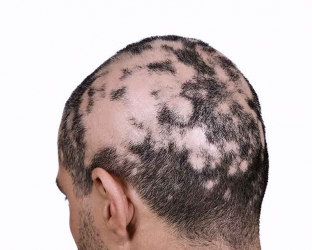Hair loss – this is an alarming symptom that signals that something in the human body is not working as it should. It is impossible not to pay attention to such a sign as periodic hair loss, because every day a person, regardless of his gender, puts his appearance in order, including paying attention to his hair.
Alopecia or baldness – This is a disease in which progressive hair loss occurs. But in modern trichology, such a type of this pathology is distinguished as temporary alopecia – occasional loss of a small amount of hair. Read about the causes and types of temporary alopecia at estet-portal.com.
Causes and main types of temporary alopecia
Recent studies have shown that true progressive alopecia affects about 40% of modern men and only 1% of women. At the same time, about 60% of women complain of temporary alopecia that occurs against the background of stress, hormonal and seasonal changes in the activity of the body, various internal pathologies and fungal infections of the scalp and hair. When referring a patient with such complaints, it is necessary, first of all, to find out whether such hair loss is temporary.
Temporary alopecia is divided into two forms of hair loss, telogen effluvium and anagen effluvium, depending on the stage of the hair life cycle.
Temporary alopecia - what forms are there
- temporary alopecia occurring in the telogen stage;
- temporary alopecia occurring in the anagen stage;
- which diseases can cause temporary alopecia.
Temporary alopecia occurring in the telogen stage
Telogen effluvium – This is a temporary alopecia that occurs in the telogen stage. The disease develops against the background of various physical and emotional stresses, in most cases, a few months after them, which is why it is so difficult for the patient to indicate the alleged cause of the pathology. As a result of stress, the hair follicles, which should have been in the growth phase for a long time, pass into the catagen stage and then into the telogen stage, after which the hair is shed and its new life cycle begins. With telogen effluvium, there is no atrophy of the hair follicles, so after hair loss in the telogen stage, new hair begins to grow.
Temporary alopecia occurring in the anagen stage
Anagen effluvium – This is a temporary loss of hair, provoked by the influence of radiation or chemical agents. With this type of temporary alopecia, hair falls out without entering the telogen phase, and the process usually begins a few weeks after exposure to a provoking factor. It is this type of alopecia that occurs against the background of chemotherapy in patients with cancer. With anagen effluvium, the hair falls out quite often in some areas, so patients are advised to cut it off before it starts to fall out. In most cases, chemotherapy-induced alopecia is reversible.

What diseases can cause temporary alopecia
Temporary alopecia can occur as a result of certain diseases, while hair loss in each individual case has its own characteristics.
Temporary alopecia can develop with the following pathologies:
- In secondary syphilis, the hair falls out in patches that look like moth marks on fabric. Diagnosis is established on the basis of anamnestic data and blood test results;
- with scleroderma, hair loss occurs as a result of compression of the hair follicles by thickened skin due to excessive production of collagen, as a result of which the blood supply to the hair is significantly impaired;
- with ringworm, the hair does not fall out, but breaks off at the root, while the foci of baldness look like round patches on the patient's head.







Add a comment